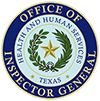October 5th, 2025

What triggers an OIG audit or investigation?
The Texas Health and Human Services (HHS) Office of Inspector General (OIG) is charged with preventing fraud, waste and abuse in health and human services programs to protect taxpayer dollars and program clients. To achieve this, OIG conducts audits, inspections, and investigations to ensure that Medicaid funds are used appropriately and efficiently. Another important fact is that TMHP (Texas Medicaid Health Portal), HHSC, and OIG are all part of the enrollment and revalidation process for HCS/TxHmL.
Some of you may be familiar, for example, with the “site visit” conducted by CMS for TMHP, for all new applications submitted for enrollment to PEMS (Program Enrollment Management Services). The OIG reviews these site visit reports and enrollments into TMHP. Some common deficiencies in this area are:
Incomplete Items-such as criminal hx checks, license checks, and managing employees or subcontractor checks.
Tips: Double-check disclosures before submitting the application or revalidation. OIG also recommends that you start the revalidation process early, it can be a very long process. During Revalidation, you may expect site visit to verify if the provider is actually at that location. This would be for re-enrollment or revalidation, as far as my understanding, and that this is not the same as the federal OIG site visit. This is the state OIG visit to verify your program is actually at that location.
Audits: To mitigate their own risks, providers should be aware of some of the issues that could lead to OIG scrutiny. Some of the common HCS/TxHmL errors seen:
–LIDDAS-lack sufficient progress notes
–Missing progress notes, service delivery logs
–False Documentation
-Facility did not have records to support telehealth-consents and records for what they are billing that meets billing requirements for what is billable
–Telemedicine must have written permission and include observation, diagnoses, training and testing
–Medication Administration: Billing For services not rendered
–Quality of Care-billing for expensive services but giving low end service/care
–Misappropriation of Funds
Some new areas that OIG has noted they are concentrating on that come under their purview are:
-Solicitation (Can’t do anything to influence the individual’s choice of provider). OIG is hitting hard in this area now and in the next year!
-Also Reviewing Cost Reports in some cases as well now. Due to complaints and due ot risk assessments they have completed concerning cost reports.
Common Triggers:
Billing errors
High Dollar Claims
Unusual Payment Patterns
Inappropriate Documentation (missing documentation for service billed, missing appropriate dates, times, signatures for each service entry of billable services, etc…)
Billing For Services Not Defined As Billable in The “Billing Requirements”
A note about common triggers
**It’s important to note that being flagged for an OIG data review does not automatically indicate wrongdoing. These flags may simply reflect billing or service patterns that differ from peers and may warrant a closer look. Tip from OIG: If you self-disclose during an audit, you may get to keep some or all of the money or at least avoid additional fees being charged.
Report waste, fraud, and abuse of HHSC programs to: ReportTexasFraud.com
For questions, please email: Jeremy.fuchs@hhs.gov

